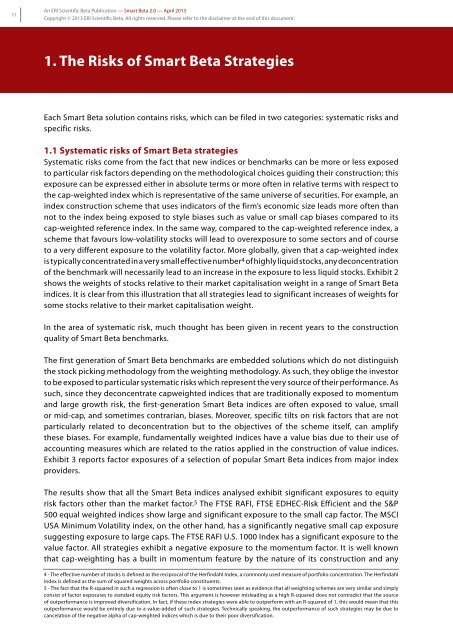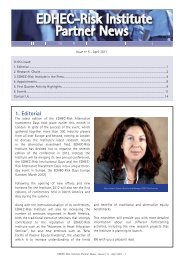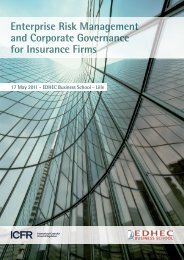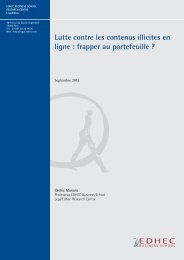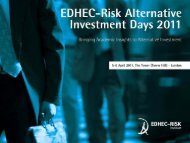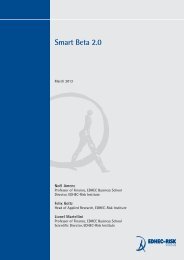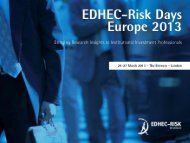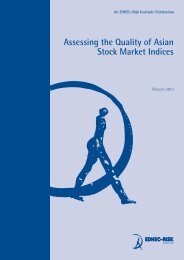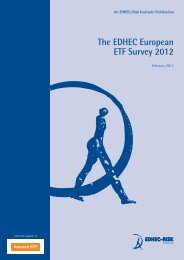The Smart Beta 2.0 Approach - EDHEC-Risk
The Smart Beta 2.0 Approach - EDHEC-Risk
The Smart Beta 2.0 Approach - EDHEC-Risk
Create successful ePaper yourself
Turn your PDF publications into a flip-book with our unique Google optimized e-Paper software.
10<br />
An ERI Scientific <strong>Beta</strong> Publication — <strong>Smart</strong> <strong>Beta</strong> <strong>2.0</strong> — April 2013<br />
Copyright © 2013 ERI Scientific <strong>Beta</strong>. All rights reserved. Please refer to the disclaimer at the end of this document.<br />
1. <strong>The</strong> <strong>Risk</strong>s of <strong>Smart</strong> <strong>Beta</strong> Strategies<br />
Each <strong>Smart</strong> <strong>Beta</strong> solution contains risks, which can be filed in two categories: systematic risks and<br />
specific risks.<br />
1.1 Systematic risks of <strong>Smart</strong> <strong>Beta</strong> strategies<br />
Systematic risks come from the fact that new indices or benchmarks can be more or less exposed<br />
to particular risk factors depending on the methodological choices guiding their construction; this<br />
exposure can be expressed either in absolute terms or more often in relative terms with respect to<br />
the cap-weighted index which is representative of the same universe of securities. For example, an<br />
index construction scheme that uses indicators of the firm’s economic size leads more often than<br />
not to the index being exposed to style biases such as value or small cap biases compared to its<br />
cap-weighted reference index. In the same way, compared to the cap-weighted reference index, a<br />
scheme that favours low-volatility stocks will lead to overexposure to some sectors and of course<br />
to a very different exposure to the volatility factor. More globally, given that a cap-weighted index<br />
is typically concentrated in a very small effective number 4 of highly liquid stocks, any deconcentration<br />
of the benchmark will necessarily lead to an increase in the exposure to less liquid stocks. Exhibit 2<br />
shows the weights of stocks relative to their market capitalisation weight in a range of <strong>Smart</strong> <strong>Beta</strong><br />
indices. It is clear from this illustration that all strategies lead to significant increases of weights for<br />
some stocks relative to their market capitalisation weight.<br />
In the area of systematic risk, much thought has been given in recent years to the construction<br />
quality of <strong>Smart</strong> <strong>Beta</strong> benchmarks.<br />
<strong>The</strong> first generation of <strong>Smart</strong> <strong>Beta</strong> benchmarks are embedded solutions which do not distinguish<br />
the stock picking methodology from the weighting methodology. As such, they oblige the investor<br />
to be exposed to particular systematic risks which represent the very source of their performance. As<br />
such, since they deconcentrate capweighted indices that are traditionally exposed to momentum<br />
and large growth risk, the first-generation <strong>Smart</strong> <strong>Beta</strong> indices are often exposed to value, small<br />
or mid-cap, and sometimes contrarian, biases. Moreover, specific tilts on risk factors that are not<br />
particularly related to deconcentration but to the objectives of the scheme itself, can amplify<br />
these biases. For example, fundamentally weighted indices have a value bias due to their use of<br />
accounting measures which are related to the ratios applied in the construction of value indices.<br />
Exhibit 3 reports factor exposures of a selection of popular <strong>Smart</strong> <strong>Beta</strong> indices from major index<br />
providers.<br />
<strong>The</strong> results show that all the <strong>Smart</strong> <strong>Beta</strong> indices analysed exhibit significant exposures to equity<br />
risk factors other than the market factor. 5 <strong>The</strong> FTSE RAFI, FTSE <strong>EDHEC</strong>-<strong>Risk</strong> Efficient and the S&P<br />
500 equal weighted indices show large and significant exposure to the small cap factor. <strong>The</strong> MSCI<br />
USA Minimum Volatility index, on the other hand, has a significantly negative small cap exposure<br />
suggesting exposure to large caps. <strong>The</strong> FTSE RAFI U.S. 1000 Index has a significant exposure to the<br />
value factor. All strategies exhibit a negative exposure to the momentum factor. It is well known<br />
that cap-weighting has a built in momentum feature by the nature of its construction and any<br />
4 - <strong>The</strong> effective number of stocks is defined as the reciprocal of the Herfindahl Index, a commonly used measure of portfolio concentration. <strong>The</strong> Herfindahl<br />
index is defined as the sum of squared weights across portfolio constituents.<br />
5 - <strong>The</strong> fact that the R-squared in such a regression is often close to 1 is sometimes seen as evidence that all weighting schemes are very similar and simply<br />
consist of factor exposures to standard equity risk factors. This argument is however misleading as a high R-squared does not contradict that the source<br />
of outperformance is improved diversification. In fact, if these index strategies were able to outperform with an R-squared of 1, this would mean that this<br />
outperformance would be entirely due to a value-added of such strategies. Technically speaking, the outperformance of such strategies may be due to<br />
cancelation of the negative alpha of cap-weighted indices which is due to their poor diversification.


